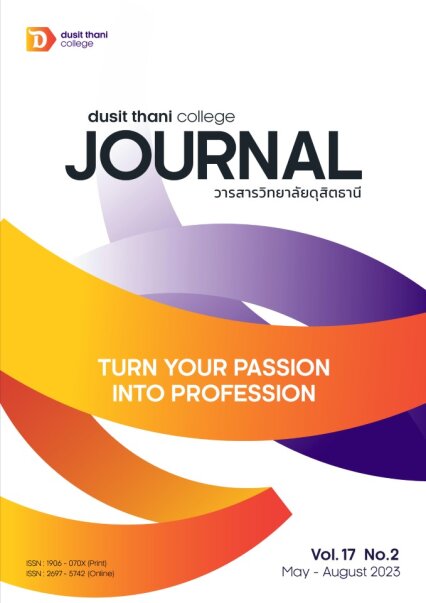Guidelines for Promoting Muslim Restaurants in Requesting Halal Certification of Restaurants in Bangkok
Main Article Content
Abstract
The objectives of this research are 1) to study the factors that prevent Muslim restaurants from not having Halal logo, 2) To create a guideline to promote the obtaining of the Halal logo of Muslim restaurants. The key informants were 20 Muslim restaurant entrepreneurs and 5 working staff in the Central Islamic Council of Thailand. The research tools were interview forms, Analytic Induction was used for data analysis. The results of the research revealed that the factors that prevented Muslim restaurants from having Halal logos were knowledge about requesting Halal logos. mismatched communication service quality fees are too high Not paying attention to requesting Halal symbols Difficult steps, etc.Guidelines for development include: establishments should follow up on delayed documents. Buy ingredients that have a Halal mark. recruiting qualified employees according to the specified criteria environment should be studied Improve locations, locations, target groups Sources of raw materials, employees, working capital And there are controls to make the raw material procurement process production process And the service is correct according to the provisions of Islam. and requirements for Halal food standards There is a systematic structure and requirements of the store.and the public sector should improve public relations and communication, requesting procedures for the establishment of responsible agencies that provide up-to-date information and are easy to verify recruiting skilled personnel knowledge of science and halal formulate laws to support Integrate different departments to work in the same direction. and reduce certification costs
Article Details

This work is licensed under a Creative Commons Attribution-NonCommercial-NoDerivatives 4.0 International License.
Article Screening Policy
- All research and academic articles to be published must be considered and screened by three peer reviews in the relevant field / article.
- All articles, texts, illustrations and tables published in the journal are the personal opinions of the authors. Editors don't always have to agree. And no responsibility whatsoever is the sole responsibility of the author.
- The articles to be published must never be published. Where did you first publish? And not in the consideration of other journals If the audit found that there has been a duplicate publication It is the sole responsibility of the author.
- Any article that the reader sees as being plagiarized or impersonated without reference. Or mislead the work of the author Please let the journal editor know it will be your greatest blessing.
References
Al-Jallad, N. (2008). The concepts of al-halal and al-haram in the arab-muslim culture: A translational and lexicographical study. Language Design,10 (2008), 77-86. Retrieved from http://journal.uinjkt.ac.id/index.php/ahkam/article/view/4459/3187#.
Deming, W. Edwards (1986). Out of the Crisis. MIT Press.
Islamic Committee of Songkhla Province. (2020). A manual for training courses, criteria and requirements regarding the production of products in accordance with Halal standards. Songkhla: PSU
Karoui, S., & Khemkhem, R. (2016). To more understanding the halal market and the Islamic consumer-factors affecting the Islamic purchasing behavior. International Journal of Academic Research in Business and Social Sciences, 6(8), 65-99.
Kotler, Philip and Armstrong, Gary. (2018). Principles of Marketing. (17th Edition). New York: Pearson Education.
Marso1,M. and Hasan,H.(2017).). Religiosity and its consequence in halal food purchasing behavior.The 8th International Conference of the Asian Academy of Applied Business (pp. 1-10).Kota Kinabalu,Sabah
Md. Monirul,I. & Mohammad A.F.C. (2018). Consumers’ buying decision process toward halal product: a study in Bangladesh. Int. J. Business Innovation and Research, 6 (3):285-301. doi:10.1504/IJBIR.2018.10009474.
Norazah Mohd Suki, et al. (2014). Measuring Muslim Consumers’ Decision to Patronize Halal Stores: Some Insights from Malaysia. Malaysian Journal of Business and Economics ,1(2),77 – 87.
Pakorn Priyakorn. (2015). The Path to Development of Halal Affairs of Thailand Workshop Program. Halal Standards for Consumer Protection, Halal Standards Workshop for Halal Consumer Protection. Bangkok: P.L.T.
Wannasupchue, W., Othman ,M., Abidin U.F.UZ., &Ishak, F.A.C.(2019). Current trends and opportunities for halal restaurants in Thailand: A conceptual framework. International Journal of Acadamic Research in Busness&Social Science,9 (1), 235 – 247.
Zeithaml, V. A., Parasuraman, A., & Berry, L. L. (1988). SERVQUAL: A multiple-item scale for measuring consumer perceptions of service quality. Journal of Retailing, 64 (1), 12–40. Retrieved from https://www.researchgate.net/publication/225083802_SERVQUAL_A_multiple_Item_Scale_for_
measuring_consumer_perceptions_of_service_quality


